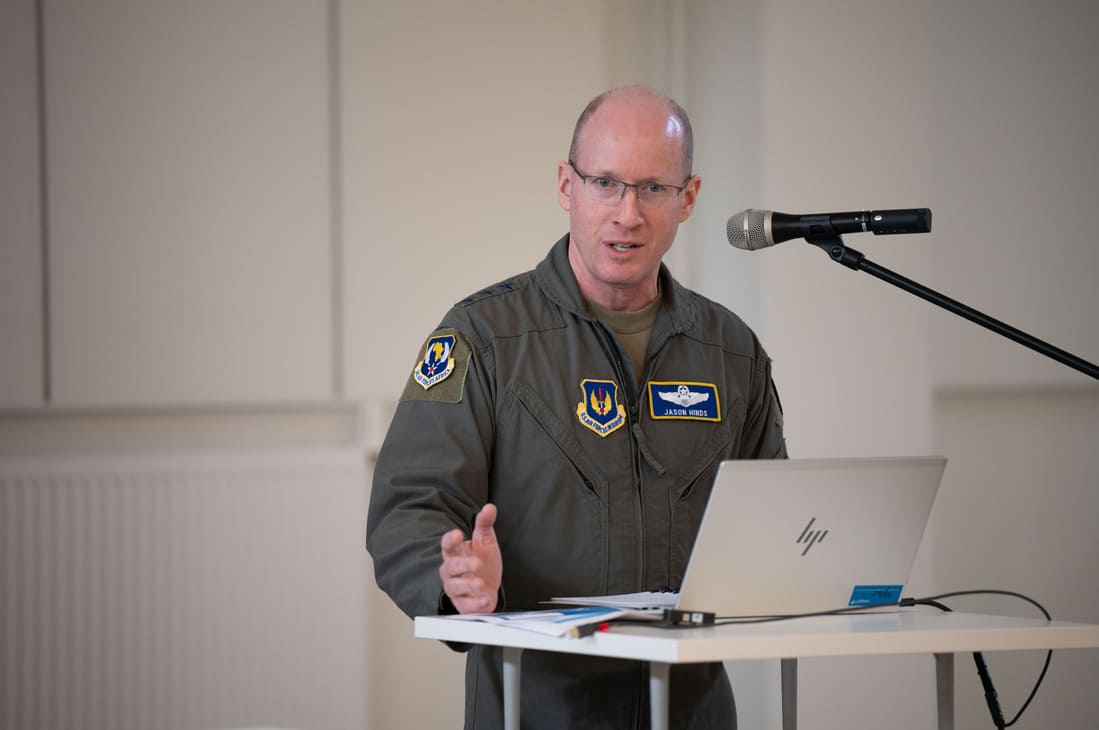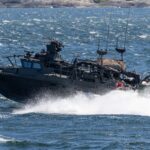President Donald Trump sent the nomination of Lt. Gen. Jason T. Hinds to the Senate on September 29 to command U.S. Air Forces in Europe-Air Forces Africa. The billet is redesignated at the lieutenant general grade, so Hinds would not receive a fourth star upon assuming command.
The acting status began in May after Gen. James B. Hecker retired. Hinds has served as USAFE-AFAFRICA deputy commander since September 2024. His background includes instructor time in the F-22 and F-15, prior wing command, and a tour as EUCOM operations director.
Defense officials confirm the dual-hat remains in place. The nominee is also put forward to head NATO Allied Air Command at Ramstein and to serve as director of the Joint Air Power Competence Centre.
The nomination package filed with the Senate lists six Air Force officers for appointment to lieutenant general, including Hinds. Committee referral occurred the same day.
USAFE-AFAFRICA’s headquarters mission continues across an area of responsibility that spans Europe and Africa. The command delivers airpower for two geographic combatant commands and supports NATO air activities from Ramstein Air Base.
According to industry sources, staff planning assumed a three-star transition window this fall because the seat became vacant with Hecker’s retirement, which simplified the grade change without needing to reassign a serving four-star.
Rank change and NATO Allied Air Command responsibilities
The four-star to three-star downgrade applies to the USAFE-AFAFRICA commander billet, a post historically paired with leadership of NATO Allied Air Command. The NATO role continues under the new U.S. grade, with Ramstein remaining the allied air headquarters.
The change introduces a difference in rank relative to several senior NATO counterparts positioned in the theater. The U.S. commander will now hold three stars while partners in allied land and maritime commands retain higher or equal grades, depending on national nominations and NATO posts.
Current theater leadership includes Air Force Gen. Alexus G. Grynkewich as the U.S. European Command commander and Supreme Allied Commander Europe. Army Gen. Chris Donahue leads U.S. Army Europe and Africa and also NATO Allied Land Command.
Stars and Stripes reporting notes an earlier U.S. review in 2012 considered making USAFE a three-star command, then reversed course. The present action revives that structural option with formal nomination paperwork on the Hill and updated service statements.
USAFE-AFAFRICA remains responsible for posture and operations that touch eight wings, multi-national air policing, and rotational presence tied to allied exercises. The personnel footprint cited by the Air Force includes about 35,000 active-duty, Reserve, Guard, and civilian members.
Defense officials confirm the day-to-day allied air command arrangements at Ramstein continue unchanged during Senate consideration. The staff at Allied Air Command sustains air tasking and readiness oversight under established NATO procedures while the U.S. nomination proceeds.
Hegseth’s directive to reduce four-star billets and related moves
Secretary of Defense Pete Hegseth issued a directive in May ordering at least a 20 percent reduction in four-star billets across the active components and a significant cut among general officers in the Guard. Department statements since then reference streamlining senior leadership layers and trimming redundant structures.
The memo campaign set the frame for a review of service major commands and component headquarters. Public remarks by the secretary at Quantico on September 30 flagged additional changes to senior leader standards, training, and oversight, paired with hints of further leadership reshuffles.
Air and Space Forces reporting in August laid out options that included reducing the rank for three Air Force organizations: USAFE-AFAFRICA, Air Mobility Command, and Air Force Materiel Command. The USAFE change is now formal through the nomination route. The two remaining commands have not been officially downgraded as of today.
The service recently forwarded several three-star nominations to the Senate in parallel moves, including a new leader for Air Education and Training Command and a commander for Space Forces-Space under U.S. Space Command. The AETC action reflects normal three-star leadership for that training MAJCOM, while the Space Force component remains one of a handful of three-star billets inside USSF.
Congressional records show the Air Force also submitted other nominations in late September, including the selection of Gen. Kenneth S. Wilsbach to serve as Chief of Staff. The filings list the docket numbers and referral to the Armed Services Committee.
Parallel personnel developments continue. Gen. Thomas A. Bussiere, head of Global Strike Command, announced his intention to retire after the withdrawal of his vice chief nomination earlier in September. Service communications and trade press covered the retirement decision in the context of senior leader churn.
Defense officials confirm the billet review ties into a broader look at the Unified Command Plan and component alignments. Public coverage has raised the possibility of folding U.S. Africa Command into European Command, but no formal consolidation has been announced.
Policy commentary pieces and news analysis in late September highlighted concerns among senior leaders about the speed and breadth of the review. Reporting described internal pushback over priorities and the focus areas inside the new National Defense Strategy.
Historical precedent and command parity in Europe
USAFE began under three-star leadership after World War II. Early commanders included then-Lt. Gen. Curtis LeMay. The elevation to a four-star billet came in 1957 during a period of intensifying Cold War tensions under Gen. Frank Everest. The three-star reversion proposed in 2012 did not carry forward at the time.
Command parity inside NATO has varied by function and nation. Allied Land Command is often led by a four-star, Allied Maritime Command by a three-star admiral, and Allied Air Command at Ramstein by the dual-hatted U.S. USAFE commander. The U.S. officer now nominated would serve in that allied air role at the lieutenant general grade.
The U.S. statutory ceiling on four-star officers and the exempt status of certain joint billets constrain how many general officer slots the services can maintain at that rank. The May directive pressed the services to rebalance within those limits and to identify headquarters for grade reductions where feasible without breaking command continuity.
Senate paperwork for Hinds and the companion nominees arrived before the current government funding turbulence. Committee calendars govern the confirmation path; in the interim, USAFE-AFAFRICA’s acting arrangements cover operational duties, and Allied Air Command maintains steady oversight of NATO air operations.
USAFE’s portfolio includes air policing in the Baltic and Black Sea regions, rotational deployments into Eastern Europe, and support to multinational training across allied airspace. The staff also integrates with U.S. African Command for episodic operations and exercises under the air component construct.
Industry contacts point to one practical effect in allied rooms. A U.S. three-star leading Allied Air Command may at times be junior to a four-star counterpart from another service or nation during combined events. The allied command structure, however, sets authorities by position and task order, not by pay grade alone, so routine decision rights remain tied to assigned roles.
The Air Force has already adjusted rank at lower echelons in Europe. Aviano’s 31st Fighter Wing passed to a colonel in July after decades under a brigadier general, signaling a willingness to recalibrate leadership grades where mission demands permit.
The personnel slate associated with the late-September nomination batch includes five other officers slated to pin on a third star and move into roles across Global Strike, AETC, the Air Force Sustainment Center, Air University, and Space Forces-Space. Each action lines up with standing responsibilities at those organizations.
Our analysis shows the USAFE downgrade aligns with a documented push to compress senior ranks and reduce four-star totals, applied first to a vacancy that could absorb the change without displacing an incumbent while preserving NATO air leadership continuity at Ramstein.
REFERENCE SOURCES
- https://www.defensenews.com/air/2025/10/02/pentagon-downgrades-leadership-role-for-air-forces-europe-to-3-star/
- https://www.airandspaceforces.com/usafe-nato-air-commander-3-stars/
- https://www.stripes.com/branches/air_force/2025-10-03/air-forces-europe-commander-downgrade-star-19307474.html
- https://www.congress.gov/nomination/119th-congress/554/1
- https://www.senate.gov/pagelayout/legislative/one_item_and_teasers/nom_cmten.htm
- https://www.airandspaceforces.com/new-commander-aetc-space-forces-space-3-star-nominees/
- https://www.airandspaceforces.com/usafe-amc-afmc-four-star-generals/
- https://www.usafe.af.mil/About-Us/Biographies/Display/Article/2187355/jason-t-hinds/
- https://www.washingtonpost.com/national-security/2025/09/29/hegseth-national-defense-strategy-trump-dissent/
- https://www.politico.com/news/2025/09/30/hegseth-meeting-generals-standards-00586122



